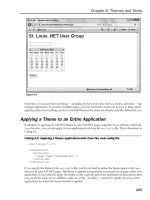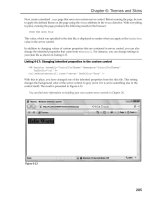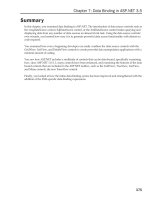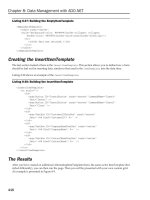Professional ASP.NET 3.5 in C# and Visual Basic Part 146 pps
Bạn đang xem bản rút gọn của tài liệu. Xem và tải ngay bản đầy đủ của tài liệu tại đây (517.95 KB, 10 trang )
Evjen c31.tex V2 - 01/28/2008 4:01pm Page 1415
Chapter 31: Configuration
then that particular setting overrides the default ASP.NET setting inherited from the
machine.config
or the root
web.config
file. The
web.config
files in the subdirectories or subfolders can override these
settings or inherit the settings (such as the 10-minute session timeout).
The configuration settings for virtual directories are independent of the physical directory structure.
Unless the manner in which the virtual directories are organized is exclusively specified, configuration
problems can result.
Note that these inheritance/override rules can be blocked in most cases by using the
allowOverride =
"false"
mechanism shown in Listing 31-3.
Detecting Configuration File Changes
ASP.NET automatically detects when configuration files, such as
machine.config
or
web.config
,are
changed. This logic is implemented based on listening for file-change notification events provided by the
operating system.
When an ASP.NET application is started, the configuration settings are read and stored in the ASP.NET
cache. A file dependency is then placed on the entry within the cache in the
machine.config
and/or
web.config
configuration file. When the configuration file update is detected in the
machine.config
,
ASP.NET creates a new application domain to service new requests. The old application domain is
destroyed as soon as it completes servicing all its outstanding requests.
Configuration File Format
The main difference between
machine.config
and
web.config
is the filename. Other than that, their
schemas are the same. Configuration files are divided into multiple groups. The root-level XML element
in a configuration file is named
<
configuration
>.Thispseudo
web.config
file has a section to control
ASP.NET, as shown in Listing 31-6.
Listing 31-6: A pseudo web.config file
<
?xml version="1.0" encoding="UTF-8"?
>
<
configuration
>
<
configSections
>
<
section name="[sectionSettings]" type="[Class]"/
>
<
sectionGroup name="[sectionGroup]"
>
<
section name="[sectionSettings]" type="[Class]"/
>
<
/sectionGroup
>
<
/configSections
>
<
/configuration
>
Values within brackets [ ] have unique values within the real configuration file.
The root element in the XML configuration file is always
<
configuration
>. Each of the section handlers
and settings are optionally wrapped in a
<
sectionGroup
>.A<
sectionGroup
> provides an organi-
zational function within the configuration file. It allows you to organize configuration into unique
groups — for instance, the
<
system.web
> section group is used to identify areas within the configuration
file specific to ASP.NET.
1415
Evjen c31.tex V2 - 01/28/2008 4:01pm Page 1416
Chapter 31: Configuration
Config Sections
The <
configSections
> section is the mechanism to group the configuration section handlers associated
with each configuration section. When you want to create your own section handlers, you must declare
them in the
<
configSections
> section. The <
httpModules
> section has a configuration handler that is
set to
System.Web.Caching.HttpModulesSection
,andthe<
sessionState
> section has a configuration
handler that is set to
System.Web.SessionState.SessionStateSection
classes, as shown in Listing 31-7.
Listing 31-7: HTTP Module configuration setting from the machine.config file
<
configSections
>
<
sectionGroup
>
<
section name="httpModules"
type="System.Web.Configuration.HttpModulesSection,
System.Web, Version=2.0.0.0, Culture=neutral,
PublicKeyToken=b03f5f7f11d50a3a"/
>
<
/sectionGroup
>
<
/configSections
>
Common Configuration Settings
The ASP.NET applications depend on a few common configuration settings. These settings are common
to both the
web.config
and
machine.config
files. In this section, you look at some of these common
configuration settings.
Connecting Strings
In ASP.NET 1.0 and 1.1, all the connection string information was stored in the <
appSettings
> section.
However, ever since ASP.NET 2.0, a section called
<
connectionStrings
> was included that stores all
kinds of connection-string information. Even though storing connection strings in the
<
appSettings
>
element works fine, it poses the following challenges:
❑ When connection strings are stored in
appSettings
section, it is impossible for a data-aware
control such as
SqlCacheDependency
or
MembershipProvider
to discover the information.
❑ Securing connection strings using cryptographic algorithms is a challenge.
❑ Last, but not least, this feature does not apply to ASP.NET only; rather, it applies to all the .NET
application types including Windows Forms, Web Services, and so on.
Because the connection-string information is stored independently of the
appSettings
section, it can be
retrieved using the strongly typed collection method
ConnectionStrings
. Listing 31-8 gives an example
of how to store connecting strings.
Listing 31-8: Storing a connection string
<
configuration
>
<
connectionStrings
>
<
add
name = "ExampleConnection"
1416
Evjen c31.tex V2 - 01/28/2008 4:01pm Page 1417
Chapter 31: Configuration
connectionString = "server=401kServer;database=401kDB;
uid=WebUser;pwd=P@$$worD9" /
>
<
/connectionStrings
>
<
/configuration
>
Listing 31-9 shows how to retrieve the connection string (
ExampleConnection
) in your code.
Listing 31-9: Retrieving a connection string
VB
Public Sub Page_Load (sender As Object, e As EventArgs)
Dim dbConnection as New _
SqlConnection(ConfigurationManager.ConnectionStrings("ExampleConnection")
.ConnectionString)
End Sub
C#
public void Page_Load (Object sender, EventArgs e)
{
SqlConnection dbConnection = new
SqlConnection(ConfigurationManager.ConnectionStrings["ExampleConnection"]
.ConnectionString);
}
This type of construction has a lot of power. Instead of hard-coding your connection strings into each
and every page within your ASP.NET application, you can store one instance of the connection string
centrally (in the
web.config
file for instance). Now, if you have to make a change to this connection
string, you can make this change in only one place rather than in multiple places.
Configuring Session State
Because Web-based applications utilize the stateless HTTP protocol, you must store the application-
specific state or user-specific state where it can persist. The
Session
object is the common store where
user-specific information is persisted. Session store is implemented as a
Hashtable
and stores data based
on key/value pair combinations.
ASP.NET 1.0 and 1.1 had the capability to persist the session store data in
InProc
,
StateServer
,and
SqlServer
. ASP.NET 2.0 and 3.5 adds one more capability called
Custom
.The
Custom
setting gives
the developer a lot more control regarding how the session state is persisted in a permanent store. For
example, out of the box ASP.NET 3.5 does not support storing session data on non-Microsoft databases
such as Oracle, DB2, or Sybase. If you want to store the session data in any of these databases or in a
custom store such as an XML file, you can implement that by writing a custom provider class. (See the
section ‘‘Custom State Store’’ later in this chapter and Chapter 22 to learn more about the new session
state features in ASP.NET 3.5.)
You can configure the session information using the
<
sessionState
> element as presented inListing 31-10.
1417
Evjen c31.tex V2 - 01/28/2008 4:01pm Page 1418
Chapter 31: Configuration
Listing 31-10: Configuring session state
<
sessionState
mode="StateServer"
cookieless="false"
timeout="20"
stateConnectionString="tcpip=ExampleSessionStore:42424"
stateNetworkTimeout="60"
sqlConnectionString=""
/
>
The following list describes each of the attributes for the <
sessionState
> element shown in the preced-
ing code:
❑
mode
: Specifies whether the session information should be persisted. The mode setting supports
five options:
Off
,
InProc
,
StateServer
,
SQLServer
,and
Custom
.Thedefaultoptionis
InProc
.
❑
cookieless
: Specifies whether HTTP cookieless Session key management is supported.
❑
timeout
:Specifiesthe
Session
lifecycle time. The
timeout
value is a sliding value; at each
request, the timeout period is reset to the current time plus the timeout value. For example,
if the
timeout
value is 20 minutes and a request is received at 10:10 AM, the timeout occurs
at 10:30 AM.
❑
stateConnectionString
:When
mode
is set to
StateServer
, this setting is used to identify the
TCP/IP address and port to communicate with the Windows Service providing state
management.
❑
stateNetworkTimeout
: Specifies the timeout value (in seconds) while attempting to store state in
an out-of-process session store such as
StateServer
.
❑
sqlConnectionString
:When
mode
is set to
SQLServer
, this setting is used to connect to the SQL
Server database to store and retrieve session data.
Web Farm Support
Multiple Web servers working as a group are called a Web Farm. If you would like to scale out your
ASP.NET application into multiple servers inside a Web Farm, ASP.NET supports this kind of deploy-
ment out of the box. However, the session data needs to be persisted in an out-of-process session state
such as
StateServer
or
SQLServer
.
State Server
Both
StateServer
and
SQLServer
support the out-of-process session state. However, the
StateServer
stores all the session information in a Windows Service, which stores the session data in memory. Using
this option, if the server that hosts the session state service goes down in the Web farm, all the ASP.NET
clients that are accessing the Web site fail; there is no way to recover the session data.
You can configure the session state service using the Services dialog available by choosing Start ➪ Set-
tings ➪ Control Panel ➪ Administrative Tools ➪ Computer Management if you are using Windows XP,
and Start ➪ Control Panel ➪ System and Maintenance ➪ Administrative Tools ➪ Services if you are
using Windows Vista (as shown in Figure 31-2).
1418
Evjen c31.tex V2 - 01/28/2008 4:01pm Page 1419
Chapter 31: Configuration
Figure 31-2
Alternatively, you can start the session state service by using the command prompt and entering the
net
start
command, like this:
C:
\
Windows
\
Microsoft.NET
\
Framework
\
v2.0.50727
\>
net start aspnet_state
The ASP.NET State Service service is starting.
The ASP.NET State Service service was started successfully.
All compatible versions of ASP.NET share a single state service instance, which is the service installed
with the highest version of ASP.NET. For example, if you have installed ASP.NET 2.0 on a server where
ASP.NET 1.0 and 1.1 are already running, t he ASP.NET 2.0 installation replaces the ASP.NET 1.1’s
state server instance. The ASP.NET 2.0 service is guaranteed to work for all previous compatible versions
of ASP.NET.
SQL Server
When you choose the
SQLServer
option, session data is stored in a Microsoft SQL Server database.
Even if SQL Server goes down, the built-in SQL Server recovery features enable you to recover all the
1419
Evjen c31.tex V2 - 01/28/2008 4:01pm Page 1420
Chapter 31: Configuration
session data. Configuring ASP.NET to support SQL Server for session state is just as simple as configur-
ing the Windows Service. The only difference is thatyourunaT-SQLscriptthatshipswithASP.NET,
InstallSqlState.sql
. The T-SQL script that uninstalls ASP.NET SQL Server support, called
Uninstall-
SqlState.sql
, is also included. The install and uninstall scripts are available in the Framework folder.
An example of using the SQL Server option is presented in Listing 31-11.
Listing 31-11: Using the SQLServer option for session state
<
configuration
>
<
system.web
>
<
sessionState
mode="SQLServer"
sqlConnectionString="data source=ExampleSessionServer;
user id=ExampleWebUser;password=P@55worD"
cookieless="false"
timeout="20"
/
>
<
/system.web
>
<
/configuration
>
ASP.NET accesses the session data stored in SQL Server via stored procedures. By default, all the session
data is stored in the Temp DB database. However, you can modify the stored procedures so they are
stored in tables in a full-fledged database other than Temp DB.
Even though the SQL Server–based session state provides a scalable use of session state, it could become
the single point of failure. This is because SQL Server session state uses the same SQL Server database for
all applications in the same ASP.NET process. This problem has been fixed ever since ASP.NET 2.0, and
you can configure different databases for each application. Now you can use the
aspnet_regsql.exe
utility to c onfigure this. However, if you are looking for a solution for older .NET Frameworks, a fix is
available at
= kb;EN-US;836680
.
Because the connection strings are stored in the strongly typed mode, the connection string information
can be referenced in other parts of the configuration file. For example, when configuring session state to
be stored in SQL Server, you can specify the connection string in the
connectionStrings
section, and
then you can specify the name of the connection string in the
<
sessionState
> element, as shown in
Listing 31-12.
Listing 31-12: Configuring session state w ith a connection string
<
configuration
>
<
connectionStrings
>
<
add name = "ExampleSqlSessionState"
connectionString = "data source=ExampleSessionServer;
user id=ExampleWebUser;password=P@55worD" /
>
<
/connectionStrings
>
<
system.web
>
<
sessionState
mode="SQLServer"
sqlConnectionString="ExampleSqlSessionState"
1420
Evjen c31.tex V2 - 01/28/2008 4:01pm Page 1421
Chapter 31: Configuration
cookieless="false"
timeout="20"
/
>
<
/system.web
>
<
/configuration
>
Custom State Store
The session state in ASP.NET 3.5 is based on a pluggable architecture with different providers that inherit
the
SessionStateStoreProviderBase
class. If you want to create your own custom provider or use a
third-party provider, you must set the mode to
Custom
.
You specify the custom provider assembly that inherits the
SessionStateStoreProviderBase
class, as
shown in Listing 31-13.
Listing 31-13: Working with your own session state provider
<
configuration
>
<
system.web
>
<
sessionState
mode="Custom"
customProvider="CustomStateProvider"
>
<
providers
>
<
add name="CustomStateProvider"
type="CustomStateProviderAssembly,
CustomStateProviderNamespace.CustomStateProvider"/
>
<
/providers
>
<
/sessionState
>
<
/system.web
>
<
/configuration
>
In the previous example, you have configured the session state mode as custom because you have speci-
fied the provider name as
CustomStateProvider
. From there, you add the provider element and include
the type of the provider with namespace and class name.
You can read more about the provider model and custom providers in Chapters 12 and 13.
Compilation Configuration
ASP.NET supports the dynamic compilation of ASP.NET pages, Web services, HttpHandlers, ASP.NET
application files (such as the
Global.asax
file), source files, and so on. These files are automatically
compiled on demand when they are first required by an ASP.NET application.
Any changes to a dynamically compiled file causes all affected resources to become automatically invali-
dated and recompiled. This system enables developers to quickly develop applications with a minimum
of process overhead because they can just press Save to immediately cause code changes to take effect
within their applications.
1421
Evjen c31.tex V2 - 01/28/2008 4:01pm Page 1422
Chapter 31: Configuration
The ASP.NET 1.0 and 1.1 features are extended in ASP.NET 2.0 and 3.5 to account for other file types,
including class files. The ASP.NET compilation settings can be configured using the
<
compilation
>
section in
web.config
or
machine.config
. The ASP.NET engine compiles the page when necessary and
saves the generated code in code cache. This cached code is used when executing the ASP.NET pages.
Listing 31-14 shows the syntax for the
<
compilation
> section.
Listing 31-14: The compilation section
<
! compilation Attributes
>
<
compilation
tempDirectory="directory"
debug="[true|false]"
strict="[true|false]"
explicit="[true|false]"
batch="[true|false]"
batchTimeout="timeout in seconds"
maxBatchSize="max number of pages per batched compilation"
maxBatchGeneratedFileSize="max combined size in KB"
numRecompilesBeforeAppRestart="max number of recompilations "
defaultLanguage="name of a language as specified in a
<
compiler/
>
element below"
<
compilers
>
<
compiler language="language"
extension="ext"
type=".NET Type"
warningLevel="number"
compilerOptions="options"/
>
<
/compilers
>
<
assemblies
>
<
add assembly="assembly"/
>
<
/assemblies
>
<
codeSubDirectories
>
<
codeSubDirectory directoryName="sub-directory name"/
>
<
/codeSubDirectories
>
<
buildproviders
>
<
buildprovider
extension="file extension"
type="type reference"/
>
<
/buildproviders
>
<
/compilation
>
Now take a more detailed look at these <
compilation
> attributes:
❑
batch
: Specifies whether the batch compilation is supported. The default value is
true
.
❑
maxBatchSize
: Specifies the maximum number of pages/classes that can be compiled into a
single batch. The default value is 1000.
❑
maxBatchGeneratedFileSize
: Specifies the maximum output size of a batch assembly compila-
tion. The default value is 1000 KB.
❑
batchTimeout
: Specifies the amount of time (minutes) granted for batch compilation to occur. If
this timeout elapses without compilation being completed, an exception is thrown. The default
value is 15 minutes.
❑
debug
: Specifies whether to compile production assemblies or debug assemblies. The default
is
false
.
1422
Evjen c31.tex V2 - 01/28/2008 4:01pm Page 1423
Chapter 31: Configuration
❑
defaultLanguage
:Specifiesthedefaultprogramming language, such as
VB
or
C#
,tousein
dynamic compilation files. Language names are defined using the
<
compiler
> child element.
The default value is
VB
.
❑
explicit
: Specifies whether the Microsoft Visual Basic code compile option is explicit. The
default is
true
.
❑
numRecompilesBeforeAppRestart
: Specifies the number of dynamic recompiles of resources
that can occur before the application restarts.
❑
strict
: Specifies the setting of the Visual Basic strict compile option.
❑
tempDirectory
: Specifies the directory to use for temporary file storage during compilation.
By default, ASP.NET creates the temp file in the
[WinNT
\
Windows]
\
Microsoft.NET
\
Framework
\
[version]
\
Temporary ASP.NET
Files folder.
❑
compilers
:The<
compilers
> section can contain multiple <
compiler
> subelements, which are
used to create a new compiler definition:
❑ The
language
attribute specifies the languages (separated by semicolons) used in dynamic
compilation files. For example,
C#; VB
.
❑ The
extension
attribute specifies the list of filename extensions (separated by semicolons)
used for dynamic code. For example,
.cs; .vb
.
❑ The
type
attribute specifies .NET type/class that extends the
CodeDomProvider
class used
to compile all resources that use either the specified language or the file extension.
❑ The
warningLevel
attribute specifies how the .NET compiler should treat compiler warn-
ings as errors. Five levels of compiler warnings exist, numbered 0 through 4. When the
compiler transcends the warning level set by this attribute, compilation fails. The meaning
of each warning level is determined by the programming language and compiler you’re
using; consult the reference specification for your compiler to get more information about
the warning levels associated with compiler operations and what events trigger compiler
warnings.
❑ The
compilerOptions
attribute enables you to include compiler’s command-line switches
while compiling the ASP.NET source.
❑
assemblies
: Specifies assemblies that are used during the compilation process.
❑
codeSubDirectories
: Specifies an ordered collection of subdirectories containing files com-
piled at runtime. Adding the
codeSubDirectories
section creates separate assemblies.
❑
buildproviders
: Specifies a collection of build providers used to compile custom resource files.
Browser Capabilities
Identifying and using the browser’s capabilities is essential for Web applications. The browser capabili-
ties component was designed for the variety of desktop browsers, such as Microsoft’s Internet Explorer,
Netscape,Opera,andsoon.The
<
browserCaps
> element enables you to specify the configuration
settings for the browser capabilities component. The
<
browserCaps
> element can be declared at the
machine, site, application, and subdirectory level.
The
HttpBrowserCapabilities
class contains all the browser properties. The properties can be set and
retrieved in this section. The
<
browserCaps
> element has been deprecated since ASP.NET 2.0 and now
you should instead focus on using
.browser
files.
1423
Evjen c31.tex V2 - 01/28/2008 4:01pm Page 1424
Chapter 31: Configuration
When a request is received from a browser, the browser capabilities component identifies the browser’s
capabilities from the request headers.
For each browser, compile a collection of settings relevant to applications. These settings may either
be statically configured or gathered from request headers. Allow the application to extend or modify the
capabilities settings associated with browsers and to access values through a strongly typed object model.
The ASP.NET mobile capabilities depend on the browser capabilities component.
In ASP.NET 3.5, all the browser capability information is represented in browser definition files. The
browser definitions are stored in
*.browser
file types and specified in XML format. A single file may
contain one or more browser definitions. The
*.browser
files are stored in the
Config
\
Browsers
subdirec-
tory of the Framework installation directory (for example,
[WinNT
\
Windows]
\
Microsoft.NET
\
Framework
\
v2.0.50727
\
CONFIG
\
Browsers
), as shown in Figure 31-3. Application-specific browser definition files are
stored in the
/Browsers
subdirectory of the application.
In ASP.NET 1.0 and 1.1, the browser cap information was stored in the
machine.config
and
web.config
files themselves.
Figure 31-3
1424









